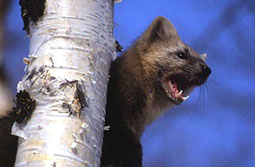Sable
Sables are predators and, like the mink and the pine marten, belong to the family of the marten or mustelidae. Sables used to have a distribution area ranging from Scandinavia to Northern China. However, at the beginning of the 20th century, intensive hunting led to a tremendous diminishing in the number of sables. Since then, their numbers have begun to increase again, but they can no longer be found in the West but only in Siberia and Northern China.
Sables are closely related to our tree martens and have the same long and slim body build, with fairly short legs and long bushy tails. Males measure 38 to 56 cm in length and weigh between 880 and 1,800 g. Females measure between 35 and 51 cm and weigh 700 to 1,560 g. Fur ranges from pale to dark brown, with usually a lighter coloring on the belly than on the back and legs. Many sables have a pale spot on their throat that can be white, grey or yellowish. A sable’s winter fur is denser, more bushy and softer than its summer fur. Its maximum life span is 8 years.
Sables are characteristic inhabitants of the Taiga. They live in dense conifer forests – in flat lands and in the mountains but never above the tree limit. Sables are loners and spend most of their lives on the ground. At night, the diurnal sable will return to the shelter of its den. If the weather is bad, for instance, in the case of snowstorms or if it is hunted intensely, sables may stay in their dens for days at a time. Therefore, they will also stock food reserves to bridge the time until they can take up hunting again. Sables primarily feed on meat. They chase and hunt small rodents and birds, squirrels, and occasionally, fish. Bird eggs are also part of their food plan. In case of food scarcity, sables will also feed on berries, nuts and plants.
Depending on the region, mating season is between mid June and mid August. If several male animals wish to mate with the same female, occassionally, serious fights will result. The embryos do not develop immediately but only after a gestation period of approx. 8 months, so that the animals may litter during a favorable time of the year. 25 to 30 days after the end of the gestation period, the female will have a litter of 1 to 7 young. As a rule, the males will not partake in the bringing up of their young. However, male animals have been observed defending female animals and their young or even bringing them food. At 35 days, the young will begin to leave their nest regularly. After 7 weeks, the mother animal will wean them and begin to feed them with meat she has chewed and spits out again. Sables reach sexual maturity at 2 years of age.

